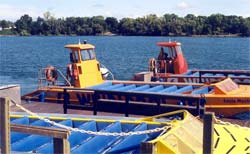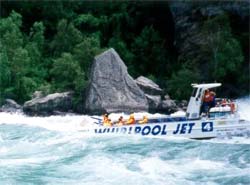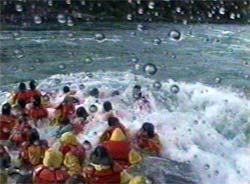Persons overboard
Water jet boat Saute Moutons 14
Niagara River Gorge, Ontario
The Transportation Safety Board of Canada (TSB) investigated this occurrence for the purpose of advancing transportation safety. It is not the function of the Board to assign fault or determine civil or criminal liability. This report is not created for use in the context of legal, disciplinary or other proceedings. See Ownership and use of content. Masculine pronouns and position titles may be used to signify all genders to comply with the Canadian Transportation Accident Investigation and Safety Board Act (S.C. 1989, c. 3).
Summary
At about 1815 eastern daylight time, while the water jet boat Saute Moutons 14 was proceeding in rapids, the forward half of the vessel became fully submerged. Two passengers were swept overboard. They were quickly rescued and suffered minor cuts and bruises.
Factual information
Particulars of the vessel
| Name | "SAUTE MOUTONS 14" | |
|---|---|---|
| Official number | 823547 | |
| Port of registry | St. Catharines, Ontario | |
| Flag | Canada | |
| Type | Passenger Water Jet Boat | |
| Gross Tons | 7 | |
| Length | 12 m | |
| Draught | Forward: 0.735 metres | Aft:0.573 metres |
| Built | 1996, Kingston, Ontario | |
| Propulsion | Diesel; two turbocharged 810 horsepower; water jets | |
| Crew Members | 3 | |
| Passengers | 43 | |
| Owner | Niagara Gorge Jet Boating Ltd. | |
Description of the vessel and its operation
The Saute Moutons 14 is purpose-built for navigating through rapids and similar white water. It is of robust construction, with high strength aluminum sections to withstand the severe accelerations and stresses to which the vessel is exposed. It is essentially box shaped, with a flat bottom, and has a shallow rise forward.
The vessel's high power, combined with the water jet configuration, permits speeds of 50 knots in calm conditions. The Saute Moutons 14 is highly manoeuvrable and can perform a unique "spin around" manoeuvre on its own axis, at high speed.
Seven rows of anti-shock, foam-cushioned and spring-dampened benches make up the passenger seating area. This area is fitted between moulded, compartmentalized buoyancy tanks, which also form part of the outer hull, sides and bottom. Immediately in front of each row of seating is a horizontal stainless steel support bar at arm's reach, grasped by the passengers to assist them in remaining seated during the whitewater ride. There is no central aisle and crew members who need to walk forward from the steering station do so on the top surface of the 0.8 metres wide, side buoyancy tanks.
There is a breakwater windshield forward, which rises approximately 0.7 metres above the foredeck. Its primary purpose is to shield passengers from large volumes of water coming over the bow. The passengers are nevertheless exposed to water coming over the top and around the sides of the windshield. However, the passengers expect the wet ride, as promotional brochures and a video viewed before the excursion illustrate this effect.
The water which accumulates in the passenger area can rise briefly to waist level before exiting through one-way water evacuation ports which are located aft, on the port and starboard sides. There are no other freeing ports. The steering and engine control station is located aft and is protected from spray by a partial enclosure with a windshield giving the operator clear visibility in all directions.
Safety precautions
A mandatory pre-departure safety briefing (approximately 10 to 15 minutes in length) includes a safety lecture and makes reference to posted signs highlighting the inherent risk of the activity. There were information brochures about the trip available, however there is conflicting information as to whether or not these were distributed prior to the occurrence. While it is not mandatory, prior to departure passengers can view a video outlining the trip upon which they are about to embark. Every passenger must wear the approved small vessel lifejacket provided and optional rain gear is available. The pre-boarding briefing also includes instruction and a demonstration of the importance of using the support bar. The operator repeats this instruction to the passengers immediately prior to traversing the rapids.
Prior to boarding the Saute Moutons 14, each passenger must fill out and sign a waiver, called a "participation agreement". The company attaches a greater risk to individuals who may be suffering from back, neck or other ailments, and the operator encourages such people to inform the staff of their medical situation. The final decision to allow or disallow a passenger's participation in the excursion is taken by the vessel's operator.
Children under the age of six and pregnant women are not allowed to take the trip. When seniors, and persons who identify themselves as having medical problems, are allowed to board, they are usually directed to sit in the after two rows of seats. This is very close to the pivot point of the vessel and as such there is less movement at this position than elsewhere on the vessel.
The passengers do not have restraining seat belts, as quick evacuation is of prime importance were the vessel to capsize. Once seated, the passengers are instructed to keep their backs straight and bodies immobile by pushing with their arms (locking of the elbows) and hands against the support bar immediately in front of them. In the event that a large wave breaks over the bow, the passengers are instructed not to lower their heads towards the support bar but to tuck their chins in against their chests. Other instructions include the request that passengers raise their arms when prompted by the operator. A "no show of hands" is taken to mean that all is not well with the passengers.
The crew consisted of a team leader, an operator and a videographer.
The operator held a limited master certificate as required by Transport Canada.
The excursion
A typical excursion departs Niagara-on-the-Lake, Ontario, at slow speed and, once clear of nearby marinas, gradually builds up to maximum speed. Upstream from Queenston, New York, the vessel begins to ascend mild rapids, the waves of which become significantly larger near the American power dam generating station. A short distance further, the rapids again increase in size, primarily due to the 20+ knot current.
In the area of high turbulence called Devil's Hole, the waves generated are compression waves which are not the result of water passing over large underwater rocks but are primarily due to a large variable volume of water being compressed into the narrow confines of the gorge. The estimated water depth in the Devil's Hole area of the Niagara River is 20 to 23 metres. The height of the waves from trough to crest is approximately 3 to 4 metres under normal conditions, and the distance between the crests can sometimes be less than the length of the Saute Moutons 14.
Once upstream of, and having by-passed Devil's Hole, the operator indicates to the passengers that they will be making a practice run with the current, starting at the Whirlpool and passing into Devil's Hole. This practice run is meant to familiarize the passengers with the vessel's movement and minimize any anxiety. The passengers are asked to raise their arms as described above. The final run proceeds from the Whirlpool, into Devil's Hole rapids and the remaining rapids before returning to Niagara-on-the-Lake. Each trip is videotaped so that passengers can purchase a copy as a memento of their tour. The round trip from Niagara-on-the-Lake normally takes about 60 minutes.
The occurrence
The two passengers, who were subsequently swept overboard, were seated on the starboard side of the second row. They are sisters. At the time of the occurrence the sisters, both in their twenties, were good swimmers and in excellent health. All passengers were wearing lifejackets.
At approximately 1730 eastern daylight timeFootnote 1 on 02 September 2001, the Saute Moutons 14 set out from Niagara-on-the-Lake with 43 passengers. The trip was uneventful until 1814, when the final trip from the Niagara Gorge Whirlpool near Devil's Hole began. Just prior to entering the Devil's Hole rapids, the passengers were asked if they wished to proceed 'sideways' into the rapids. Reportedly, the majority of passengers agreed (see Appendix A - Area of Occurrence).
The expression 'proceeding sideways' into the rapids means that the vessel encounters the large waves at an oblique angle and side slips into the trough. The result of this is that the volume of water shipped into the starboard and port forward passenger seating areas is substantially increased.
While manoeuvring in this fashion, the operator navigated the vessel into the Devil's Hole rapids and more water than usual was shipped aboard. Based on the comparisons of this trip's video with videos of previous trips, the speed of the Saute Moutons 14 appeared to be maintained. As the trip progressed, an on-board video camera, operated by a crew member, recorded a deluge of water - increasing in frequency and volume - being shipped over the bow and windshield. The passengers were waist and chest deep in water. In addition, due to the constant spray, there was very little opportunity for the forward three or four rows of passengers to catch their breath.
At approximately 1815, about three quarters of the distance through the rapids, the passenger area remained full with water and the vessel approached in quick succession, a large trough and subsequent wave. The vessel proceeded into the trough and wave with no let up in speed. The forward section of the vessel's windshield and the forward half of the passenger complement disappeared from view, after having passed through the wave. These passengers were completely submerged for approximately four to five seconds beyond the wave before the forward half of the vessel rose to the surface.
As the bow of the vessel was under water and rising to the surface, the outflow of water carried the outboard of the two sisters over the side. The inboard sister attempted to keep her on board but was carried or pulled overboard. At this time the operator had reduced power which slowed the vessel and at the same time noticed the second passenger going over the starboard side.
The trip leader, who was then seated in the first row, was not immediately aware that two passengers had gone overboard. After a number of passengers raised the alarm, the trip leader proceeded over several rows of seats to the side of the vessel, aft of midships, and noticed one person in the water. With the assistance of several passengers, the trip leader brought the person (first sister overside) aboard within five seconds.
The operator advised that he did not need to manoeuvre the water jet boat in order to have the second sister brought aboard. The vessel crew reported that they had not lost sight of the second sister and that they had her back aboard within 15 to 20 seconds.
Both sisters subsequently stated that their time in the water was longer than that reported by the crew, and that they were sucked down for part of that time.
An on-board assessment by the crew determined that immediate hospitalization was unnecessary, so the vessel returned to its base. On arrival at approximately 1830, a staff member, who held a full time position as an Emergency Medical Services paramedic, could not detect any signs of shock or trauma. They were given some bandages for the cuts and abrasions to their hands and legs.
Analysis
Performance of Saute Moutons 14 with residual water aboard
The excursion jet boat ride is advertised as a wet ride and the open passenger seating compartment is intermittently filled with water to waist level. While the water is evacuated relatively quickly through two one-way evacuation port openings at the after end of the passenger seating area, when so loaded with water, the vessel's draught increases. When moving ahead it is thus deeper in the water and tends to be less lively. The reduced freeboard also caused a large volume of water to flow over the port and starboard bows.
Immediately prior to the occurrence, the time between wave encounters did not allow the vessel to evacuate the water and re-acquire its normal operating draught. Thus, when the vessel bow dipped down into the next wave trough it did not rise with the next approaching wave but rather ploughed into it. The vessel continued to submerge its bow at a location beyond the wave as seen in the trip video replay. The availability of the high engine horsepower (1620 hp) applied to the water jets allowed the operator to continue to move the vessel, with the passenger compartment in a flooded condition. Power was not reduced until the forward section of the vessel had been driven underwater.
Operator situational awareness
The operator of a water jet boat needs to split his attention between the safe navigation and manoeuvring of the vessel and the safety of the passengers with respect to their seated positions and also to their level of water exposure. The operating company has detailed experience and training requirements to be met before an operator is allowed to navigate a passenger water jet .boat. The operator of the Saute Moutons 14 had been operating the vessel for three seasons without undue incident. During this time there was no report of a passenger injury while he was operating the vessel.
Prior to the occurrence, a speed was maintained that did not allow the time needed for the vessel to recover, or nearly recover, its normal operating draught before proceeding into the next wave. During this period, the level of awareness respecting passenger safety was less than adequate.
Risks to passengers
There is no record of other passengers being carried overboard in the history of company operations. Since operations began, the company has carried over 500 000 passengers without undergoing a similar occurrence. Other past information concerning passengers who involuntarily enter rapids, is very limited.
Just prior to the time of the Saute Moutons 14 occurrence, the passengers were subjected to substantial water flow pressure against their upper bodies while moving ahead underwater. The known risks associated with the ride, described as a 'thrill wet ride', were increased when the forward section of the vessel proceeded ahead submerged. This action went well beyond what the passengers expected.
Medical assessment of the victims
The recovered persons were assessed by a paramedic in the operating company's employ upon the vessel's return to Niagara-on-the-Lake. Based on the paramedic's assessment, they did not need further medical attention except for small cuts and abrasions. It has been indicated that a person entering the turbulent waters of 'white water' rapids will possibly experience some disorientation which could magnify the original traumatic experience.
Findings
Findings as to causes and contributing factors
- The manner in which the operator was manoeuvring the vessel for a brief moment prior to the occurrence indicates that he was not sufficiently cognisant or aware of the danger to which the passengers were exposed.
- Engine power, in excess of that required for normal operating parameters, appears to have been maintained just prior to and during the time of the occurrence.
- There was insufficient time between wave encounters for the Saute Moutons 14 to evacuate the water shipped aboard before the bow and forward passenger area became submerged.
- While the vessel's bow was resurfacing, large volumes of water flowed out of the passenger compartment and one person, followed by another, was carried overboard.
Safety action
Action taken
At the end of the 2001 season, Niagara Gorge Whirlpool Jet Boats Ltd. advised that the bailing ducts, which evacuate water from the passenger area, were expanded in size and re-designed. The previous design incorporated a 90 degree turn in the duct. The new design and larger construction will allow the same volume of water to be evacuated in a straight line direction aft and thus shed water faster from the passenger seating area. The weight of the water exiting in the reconstructed tubes helps to bring the bow up and drop the stern, further helping to trim the boat.
This report concludes the Transportation Safety Board's investigation into this occurrence. Consequently, the Board authorized the release of this report on .



